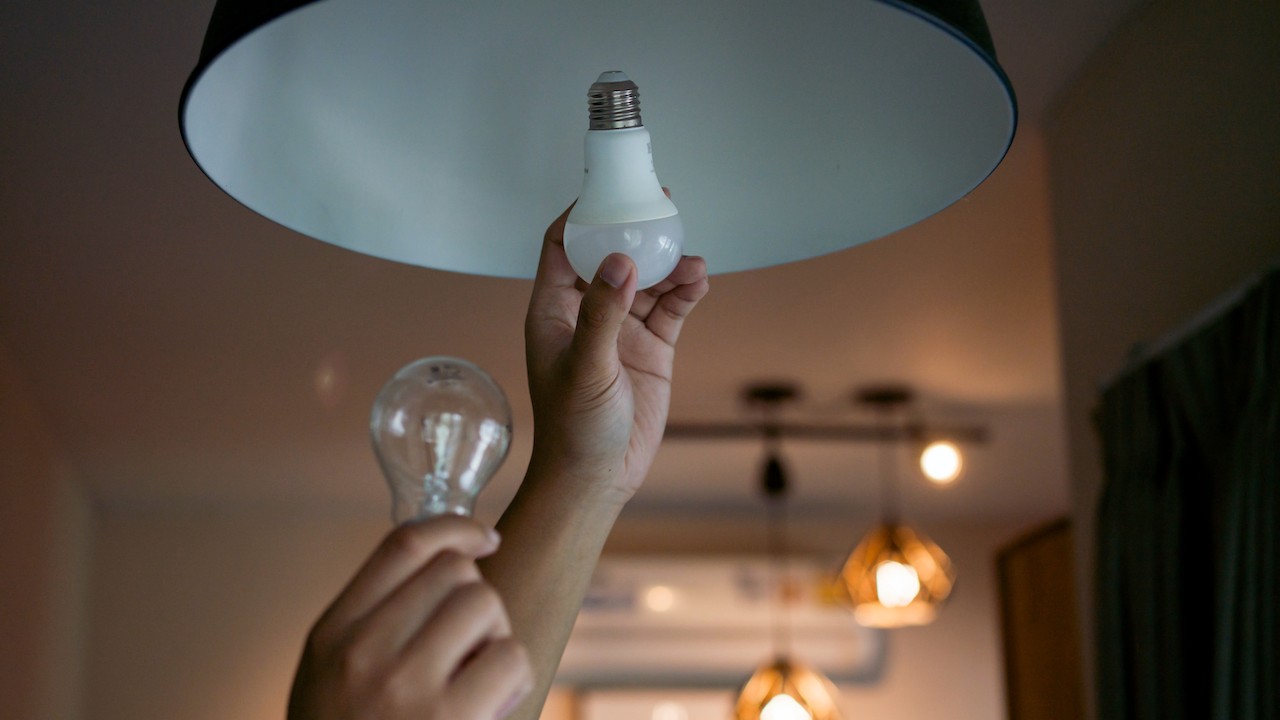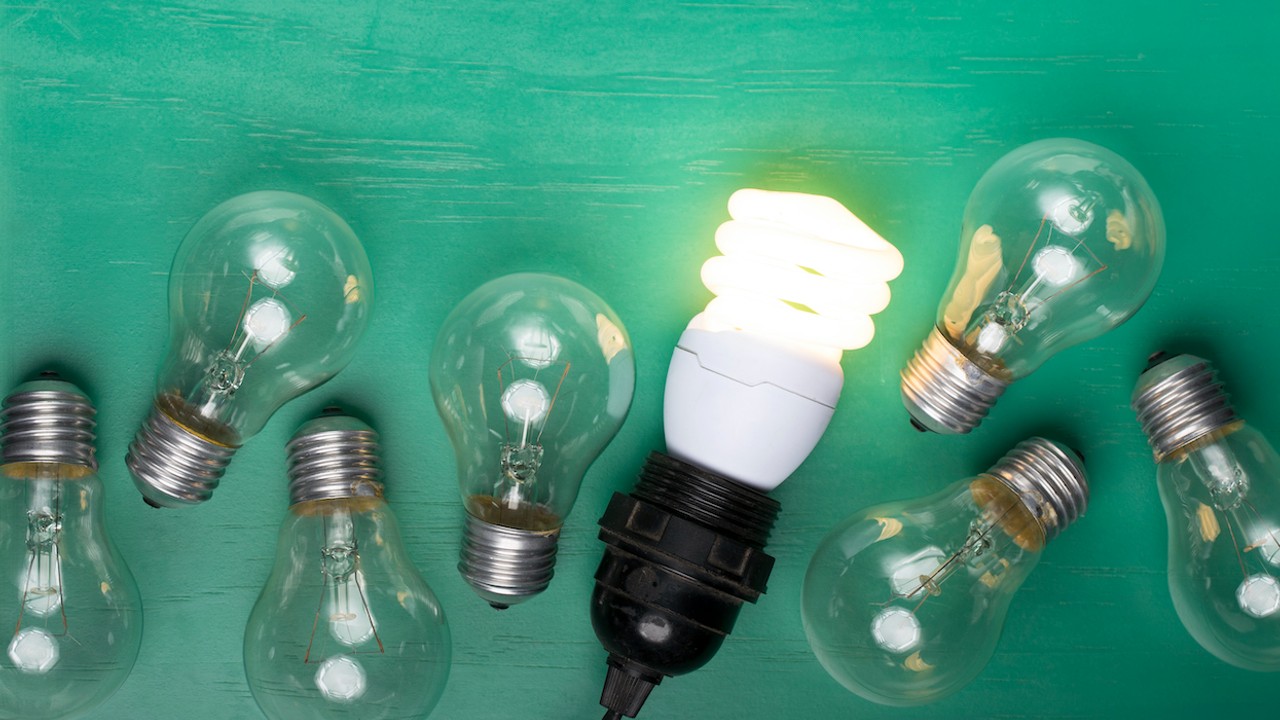How do energy saving light bulbs work?
Here’s why energy saving light bulbs have become so popular and how they light up our homes, schools and workplaces.

Energy saving light bulbs were invented as a greener alternative to traditional bulbs, needing 90% less electricity to produce the same light, according to the Centre of Sustainable Energy. But how do they do it?
As bright ideas go, it’s almost impossible to overstate the impact the humble light bulb has had on human civilization. Before Thomas Edison had the original ‘light bulb moment’ and patented his invention all the way back in 1879 people were literally living in the dark ages, according to the Franklin Institute. People depended on oil or gas lamps and candles to light their rooms and streets, and when the sun went down the world would look much duller than it does today.
The light bulb changed all that and enabled us to have cheap, reliable and powerful lighting at the flick of a switch. They revolutionized how we work and relax after dark, impacting how we build our streets and all of our modern buildings too and ensuring that when the sun goes down, life goes on.
Related: 7 scientists who helped change the world
The traditional light bulb
A traditional or 'incandescent' light bulb, consists of a piece of hardy metal wire with a very high melting point, typically made of tungsten, surrounded by a glass cover, according to the BBC. When electricity passes through it, it makes the wire glow, producing the light that fills the room. If you imagine a poker glowing red after being held in a fire, that’s pretty much what the inside of the light bulb and how it emits light.
One of the problems with traditional bulbs, however, is that much of the energy they use is not actually turned into light, but heat, which is why you have to wait for them to cool down before changing them. Only 10% of the energy an incandescent light bulb uses is turned into light, according to Penn State University. This makes them extremely inefficient for what we actually need them to do — after all, nobody turns on a light to stay warm, do they?
Also, the heat irreparably damages the filament to a point where it no longer works, the lightbulb breaks and has to be replaced. This has huge implications for both waste and cost.
So for many years, scientists and engineers have been working on replacements for the traditional light bulb that would be kinder to the environment without compromising on effectiveness.
Energy saving light bulbs

Certain types of energy saving light bulbs have actually been around for decades. One of the first was the halogen bulb developed in 1955, according to the Edison Tech Center.
They use the same filament technology as traditional bulbs but have some important differences.
Halogen bulbs are similar to incandescent bulbs but contain a small amount of halogen gas which mixes with tungsten vapor. It then deposits it back onto the filament instead of on the inside of the bulb, meaning it can shine more brightly and extends the bulb's lifespan.
This all makes them a little bit more efficient, but far from perfect. Back in 2009 the European Union began to phase out inefficient light bulbs, including halogen bulbs, according to The European Consumer organisation. The production and importation of directional mains-voltage halogen bulbs was also banned in the United Kingdom in September 2021, according to the UK government.
In 1976 we saw compact fluorescent lamps (CFLs) emerge, according to the Edison Tech Center. They were the first truly energy efficient bulbs available to everyday consumers and used between 70% and 80% less energy than a traditional bulb, according to the Energy Saving Trust. They can last for around 8,000 hours — 50 times longer than an incandescent bulb – making them much more efficient and cost-effective.
Related: Electricity basics: Resistance, inductance and capacitance
These bulbs light up when an electric current is passed through a tube containing a gas called argon and a tiny amount of mercury vapor. This process then generates ultraviolet light which is invisible but which excites the molecules in a fluorescent coating — called phosphor — on the inside of the tube, which then emits visible light, according to the National Institute of Environmental Health Sciences. They marked a big step forward in energy saving technology and are still the most commonly used type of energy saving bulb in use today.
Related: What is renewable energy?
An even more efficient type of energy saving bulb is the LED — light emitting diode — light. Although they actually trace their roots back to 1927 we only really started to see them in widespread use in the couple of decades, according to the Edison Tech Center. But they were pricey. Now they are more affordable and likely to be found in most places, from homes to office buildings. Because they turn up to 95% of their energy into light, they are far more efficient than traditional bulbs and last much longer, according to the University of Wisconsin.
An LED differs from all the others as solid matter produces the light, not filaments or gases. This solid state material is a semiconductor called a diode, which is made of material – usually aluminium-gallium-arsenide (AlGaAs) — that allows electricity to pass through it easily, according to Biopolymer Composites in Electronics. When the electricity passes through the diode, it emits electromagnetic particles called photons which produce the light we see in our rooms and on our streets.
LED bulbs can last for up to 50,000 hours so may not have to be replaced for up to ten years, unlike traditional bulbs which often only lasted for months or even just weeks, according to the New York Times.
Environmental impact
While energy saving light bulbs are more efficient and help consumers save money, their real benefit is to the environment.
For example, LED lights need much less energy to produce light. A typical 84-watt fluorescent bulb can be replaced by a 36 watt LED and it will provide the same level of light, according to Innovation in Global Green Technologies 2020. In simple terms, by using less energy, then less needs to be produced at source, for instance, using fossil fuels at a power station, in order to light our homes and cities. This, by extension, decreases greenhouse gas emissions.
Also, unlike some previous generations of bulbs which contained materials like mercury, LED lights don’t contain any toxic materials, meaning they can be easily disposed of in a way that will not harm the environment.
When you consider the millions of bulbs used to light the homes, streets and offices of just one country like the UK, the benefits to the world of replacing bulbs with more energy-efficient sources has huge potential to support the green agenda.
Additional resources and reading
For more information about sustainable energy and changes you can make to be eco-friendly, check out The Sustainable(ish) Living Guide by Jen Gale.
If you've got a budding engineer or environmentalist at home how wants to learn more about energy saving light bulbs and renewable energy, NASA has an easy to follow guide on how they work and much more.
Bibliography
- N.Khan and N.Abas. "Comparative study of energy saving light sources," Energy Reviews, Volume 15, January 2011
- M.E. Emetere et al. "A review on electrical bulbs and its improvement over time: Saving energy or life?", IOP Conference Series: Materials Science and Engineering, Volume 1107, August 2020
- Energy Saving Trust, "A quick guide to LEDs ahead of the halogen bulb ban" August 24 2021.
Sign up for the Live Science daily newsletter now
Get the world’s most fascinating discoveries delivered straight to your inbox.

Mark Smith is a freelance journalist and writer in Liverpool, England. A graduate in Information Systems, he has written on business, technology and world affairs for organizations ranging from the BBC, The Guardian, The Telegraph and How It Works Magazine, as well as magazines and websites in the United States, Europe and South East Asia. Subjects of his writing have ranged from quantum computing to the VFX of Tron. He is the author of "The Entrepreneur's Guide to the Art of War," which Booklist called "Essential reading for the business leaders of tomorrow and a fascinating study of the boardroom as the new battlefield."










